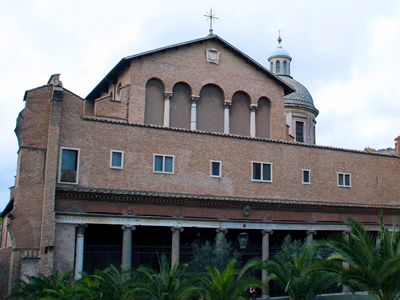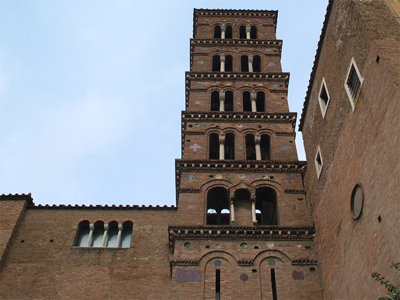SUN AN’ SOUL - DREAM AN’ ROME
CLAUDIANUM, SS. GIOVANNI E PAOLO, CLIVUS SCAURUS, ROMAN HOUSES
 |
| Claudianum - click to enlarge |
The temple of Divine Claudius (Claudianum), was an imposing construction begun by Agrippina the Younger, in the 54 to honor her husband Claudius deified after death, but Nero the son of Agrippina, adopted by Claudius, modified the northern side of the area including in his Domus Aurea.
The temple was built on a rectangular platform of 200 meters by 180, supported by the works of containment in part still visible from the Colosseum.
Remains of the outer walls of the temple are still visible embedded in the bell tower of Saints Giovanni e Paolo church and in the convent, where you can observe the travertine arches with just rough-hewed blocks, typical of the Claudius age. On the arcades runs a large lintel on which rests the medieval convent.
The church of Saints Giovanni and Paolo is located on a part of the Claudianum.
 |
| Church of Saints Giovanni and Paolo - click to enlarge |
According to the traditions the two Saints were brothers martyred for their faith in Christ, by Julian the Apostate in the fourth century, or by Diocletian in the third century. Anyway Senator Bizante and then his son Pammachius (portrait inside the church by Aureliano Milani)
since the beginning of the fifth century, built, in the place where the two saints were martyred, a church that had the name of Titulus Pamachii or Tiitulus Byzanti, ie property of Pamachius or Bizante.
Like the nearby basilica of Santi Quattro Coronati it was damaged by the Normans of Robert Guiscard in 1084 and just as that was restored by Pope Paschal II, who built the porch and the beautiful 6 orders (=flats) bell tower, which rests on the South corner of the Claudianum.
 |
| Church of Saints Giovanni and Paolo, bell tower - click to enlarge |
Remarkable in the porch the portal, made by the Cosmati masters with the two lions at the side and the eagle in the architrave.
The interior, deeply restored in 1720, with its chandeliers looks more like an hall than a church.
The apse with Christ in Glory was painted in 1588 by Nicolò Circignani, one of the three painters that to be born in Pomarance are called Pomarancio.
To admire the beautiful stained glass windows and the floor by Cosmati masters.
 |
| Church of Saints Giovanni and Paolo, interior - click to enlarge |
Under the church in 1887 Father Germano discovered the so-called “Roman Houses”.
By clivo di Scaurus, the ancient Roman road opened by the gens Aemilia Scauri in the second century BC can be accessed to these Houses, that are below the church of Saints Giovanni and Paolo,
from the late nineteenth century were excavated and gradually brought to light.
Today we can see a little museum and 20 rooms of which 13 frescoed.
The first settlement dates back to the second century AD and consisted of two Insulae, that is, popular habitations, then in the third century the Insulae disappeared to make room for a frescoed Domus.
In the fourth century, the property passed to Senator Bizante who destined to Christian worship some rooms of the Domus. Finally when the upper church was built, many of these environments were either filled up or were used as foundations.
Since 2002 this striking complex is opened to the public that can admire the sophisticatied frescoes, especially impressive is the marine scene, as well as worthy of a rich Roman Domus are the mosaics of the floors.
Among the interesting exhibits note the Arab majolica
that decorated the bell tower.
 |
| Frescoed Domus - click to enlarge |
back |

